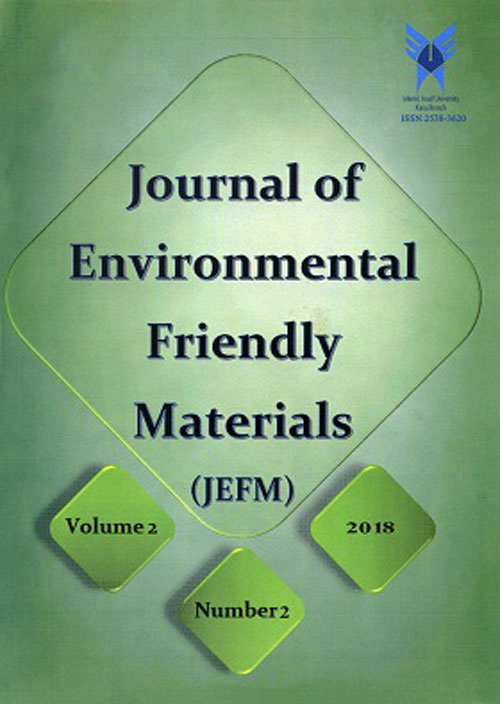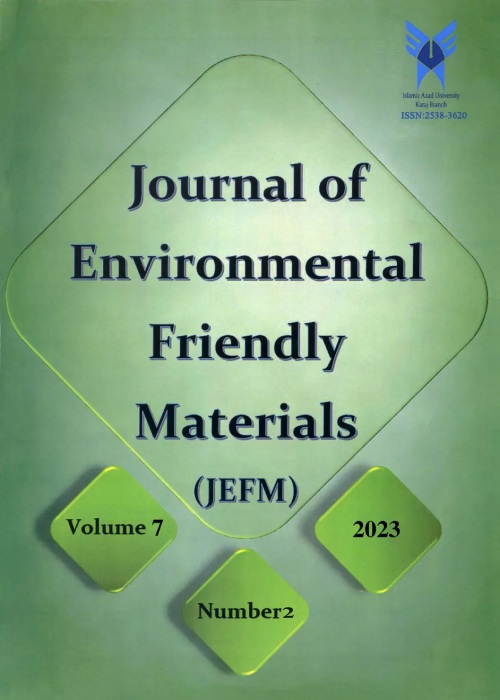فهرست مطالب

Journal of Environmental Friendly Materials
Volume:1 Issue: 1, Winter-Spring 2017
- تاریخ انتشار: 1395/12/11
- تعداد عناوین: 8
-
Pages 1-6In this study, the effects of boron (B) and zirconium (Zr) on the microstructure and high-temperature strength of Fe3Al-based alloys were investigated. Alloying was performed in a vacuum induction melting furnace (VIM) and, consequently, the melt then was poured into a cast iron mold. Microstructural investigation was conducted using optical and electron microscopy, X-ray diffraction, and differential thermal analysis. Addition of B and Zr to the alloys resulted in the formation of boride precipitates and Laves phases. Dendritic microstructures were found in as-cast alloys because of segregation of alloying elements into the interdendritic regions. To evaluate the high-temperature mechanical properties of the alloys, hot pressure test was performed. The results showed that, Zr exhibited the most pronounced effect on the high-temperature strength because of the formation of Laves phases. Boride phases tend to coarsen when increasing the temperature to 650°C, and they have no effect on the high-temperature strength of the alloy. In the temperature range of 450°C–550°C, an anomaly in the temperature-dependence of the yield strength was observed.Keywords: Iron aluminides, Boron, Zirconium, Yield stress, Casting, Microstructure
-
Pages 7-10In this research, Fe-C-B hardfacing layer fabricated with cored wire contains ferroboron on mild steel by FCAW process. OES, ICP, XRD, OM, SEM, and microhardness method were used for study of characteristics of hardface layer. The chemical analysis test results show that boron was absorbed in hardface layer. The XRD, OM, SEM, EDS results, shows that the microstructure consisted of primary Fe2B, FeB and eutectic structure (A+M+Fe2B) in hardface layer. The hardness test (HRC) results show that hardness of hardface layer was increased than that the base metal. The wear test results shows, in dry (ASTM G65) and wet (ASTM G105) conditions, the Fe-C-B hardface layer has higher wear resistance than that the mild steel and the wet wear resistance of the Fe-C-B hardface is higher than that the dry conditions. In addition, SEM observation of worn surfaces indicated that the wear micromechanism of hardface samples in dry condition was microploughing with cutting, but in the wet condition, was microploughing with pittingKeywords: Fe-C-B, Hardfacing, FCAW, Mild Steel, Abrasive Wear
-
Pages 11-18The comparison of martensitic transformation sequences between aged Ti-50.6 and Ti-51.0 at.%Ni alloys have been investigated by differential scanning calorimetry (DSC) and in-situ scanning electron microscopy (SEM). Ti-50.6 and 51.0 at.% Ni alloys were selected for evaluation of Ni concentrations. These alloys were heat-treated at 1223 K for 3.6 ks and then aged at 773 K for 3.6 ks. Although the Ti-50.6 and 51 at. % Ni alloys revealed the triple stage transformations during cooling, but the results of in-situ SEM observations showed that the sequence of these transformations was completely different from each other. Although, the distribution and size of Ti3Ni4 precipitates observed in various compositions were different from each other, but the heterogeneity in distribution and size of precipitates was a common feature of them. For both of the compositions, martensitic transformation sequences are quantitatively proved by comparing DSC measurements and SEM observations. The calculations show good agreement between DSC cooling curve and SEM observation results.Keywords: Ti-Ni alloy, Multistage martensitic transformation, Ni concentration
-
Pages 19-25The use of aluminum in automotive industry is expanding. Aluminum offers a lower weight alternative to steel, potentially increasing the efficiency of vehicles. However, the application of aluminum has been only in select areas of use, most notably cast aluminum in the engine, transmission, and wheels. Other areas offer the potential for growth that could significantly expand the amount of aluminum used in vehicles. Cost is the main barrier to increased aluminum use. Related to cos aluminum production technologies that are not yet advanced enough to produce aluminum components at low enough price points for aluminum to compete with traditional automotive materials. The amount of aluminum used in cars and light trucks is growing steadily. However, without new developments in aluminum recycling technologies, sheet from automotive aluminum could eventually flood all current markets for recycled aluminum. Environment-friendly production of automobiles is an important research subject for auto-maker companies. Production rate of automobiles increase yearly and therefore End-of-Life Vehicles (ELVs) increase. Companies who produce metallic parts have special view on ELVs as raw materials. To reach required product qualities with lowest costs, aluminum postconsumer scrap is currently recycled using strategies of downgrading and dilution, due to difficulties in refining. These strategies depend on a continuous and fast growth of the bottom reservoir of the aluminum downgrading cascade, which is formed by secondary castings, mainly used in automotive applications. With the global warming of concern, the secondary aluminum stream is becoming an even more important component of aluminum production and is attractive because of its economic and environmental benefits. Recycling of ferrous metals are easier because of separation by magnetic condition and recycling technologies. Non – ferrous metals have wide range of chemical analysis and require special technologies for separation from other metals so special look is necessary to recycling this type of metals. Effective strategies need to include an immediate and rapid penetration of dramatically improved scrap sorting technologies for end-of-life vehicles and other aluminum applications. This article concern the benefits and limitations and the challenges in direction of recycling of aluminum parts from used cars.Keywords: Recycling, Secondary Aluminum, End of Life Vehicles, Automotive Recycling
-
Pages 26-31Titanium alloys are widely applied to marine, biomaterials, chemical, petrochemical and automotive industries because of their unique property such as excellent creep resistance, corrosion resistance and relative higher specific strength ratio. However, they suffer from poor tribological properties such as low surface hardness and absolute values of tensile and shear strength which result in low wear resistance. On the other hand when Ti alloys are worn, they produce a dark-colored dust which is not environmental friendly. This project is aimed at producing hard and wear resistant particles in a matrix of Commercially Pure Titanium (CP-Ti) substrate by TIG (Tungsten Inert Gas) surface alloying. Different mixtures of Molybdenum and Titanium Carbide powders were applied to the surface in order to improve the hardness of surface layers. The microstructure of TIG alloyed layers were analyzed by OM, SEM and E-DAX. It was found that the hardness of the treated layers was more than three times higher than that of the CP-Ti substrate. Moreover, the wear resistance of this coatings were between 60 to150 times better than the base material.Keywords: CP Titanium, Surface alloying, Molybdenum, Titanium carbide, wear resistance
-
Pages 32-39In this investigate, plain carbon steel cladded by SMAW in single, two and three- pass with two hardface electrodes containing molybdenum, tungsten, and vanadium. Scanning electron microscopy, X-ray diffraction, wear tests and microhardness test were carried out to evaluate the microstructure and wear properties of hardface layers. The results indicated that by increasing of molybdenum concentration in hardface layer, M6C and M7C3 carbides were appeared in the microstructure. Moreover, by increasing the number of hardfaced layers and reducing dilution, the concentration of alloying elements, and the carbides coarser increased at microstructure. Also by increasing the percentage of the molybdenum the hardness of layers increased up to the 61 HRC and 1540 Vickers at the three-pass. In addition by increasing the number of passes the wear resistance of the hardfaced layers increased.Keywords: Hardfacing, SMAW, complex carbide, Fe-C-Cr
-
Pages 40-45Mg is considered promising degradable material for tissue engineering applications because of good biocompatibility, corrosion and mechanical properties. In the present work, biodegradable porous Mg-1 wt% Zn scaffold was produced by powder metallurgical process and then nano hydroxyapatite (HAP) coating with composition of Ca10(PO4)6(OH)2 on the scaffold was synthesized by pulse electrodeposition and alkali treatment processes to increase the corrosion resistance of the substrate. The results showed that the as-deposited coating consists of HAP, CaHPO4.2H2O (DCPD) and Ca8H2(PO4)6.5H2O (OCP) with plate-like and needle-like morphologies and the post-treated coating was composed of needle-like structure of nano HAP developed almost perpendicularly to the substrate .Electrochemical tests indicated that the corrosion current density reduced from2.731×10-3 to 4.98×10-5 A.cm-2 and the corrosion potential of scaffold increased from -1.451 to -1.37 V. This study revealed that electrodeposition of HA coating is a useful approach to improve the corrosion resistance of porous Mg-Zn scaffold in SBF and to develop Mg-based degradable implants.Keywords: biodegradable scaffold, Mg–Zn, HAP coating, Electrodeposition, Corrosion Resistance
-
Pages 46-57In professional industries have taken an interest in being more environmentally friendly, it is important that all adopt a unified standard regarding environmental preservation. In this investigating the increase in demand for electricity in the world a continuous search for new sources of energy, engineering and technology solutions. Heat recovery system generator (HRSG) is obviously a very desirable energy source, since the product is available almost operating cost-free and increases the efficiency of the cycle in which it is placed, either for steam generation or for incremental power generation. Increasing thermal efficiency while reducing energy costs is possible through the use of finned tubes for heat exchangers. Welding contact currents frequency is a variation of resistance welding which uses high-frequency properties of the welded contact surface heating elements to melt temperature, and combinations thereof by pressure. Finned tubes used a HRSG is the core facility of a combined cycle thermal power plant that recycles thermal energy from a gas turbine and creates high temperature and high pressure gas. This paper presents the technologies of environment friendly industrial fin tube boiler, with particular emphasis on high-frequency resistance welded (HFRW) finned tubes.Keywords: Finned tube, High-frequency, Resistance Welding, Heat recovery steam generator


